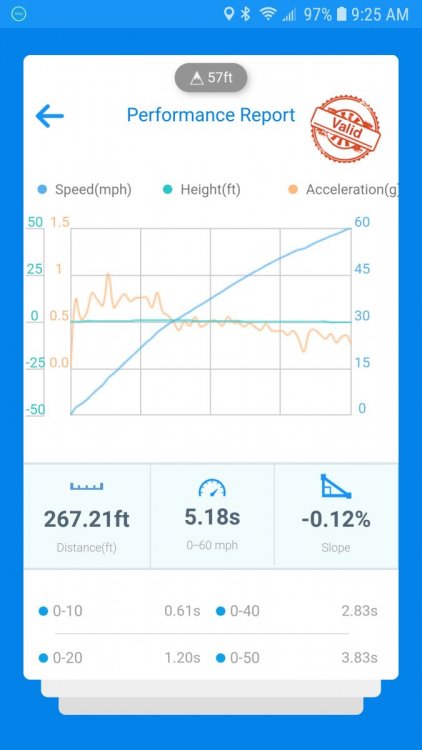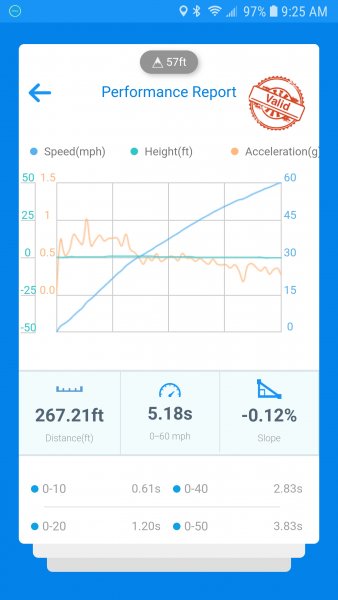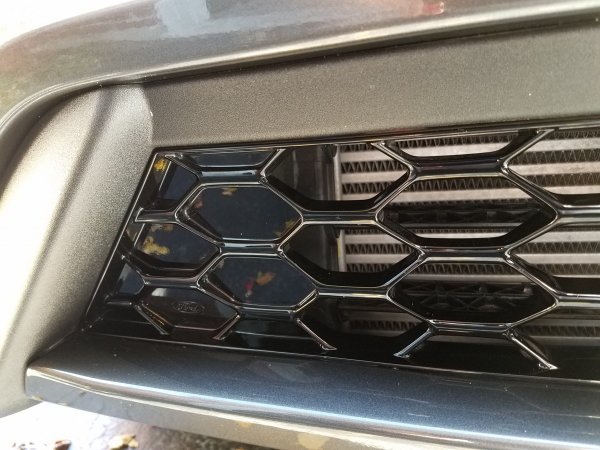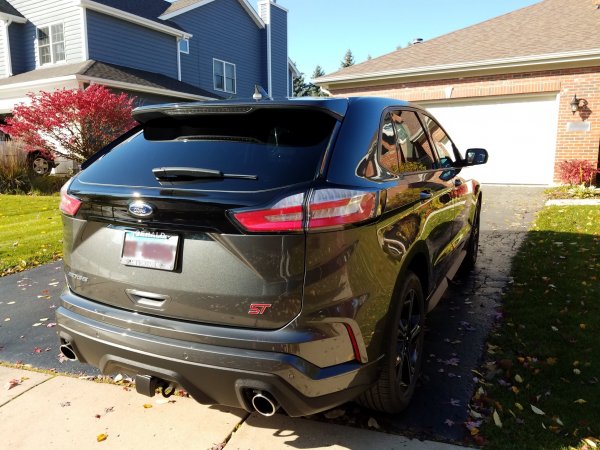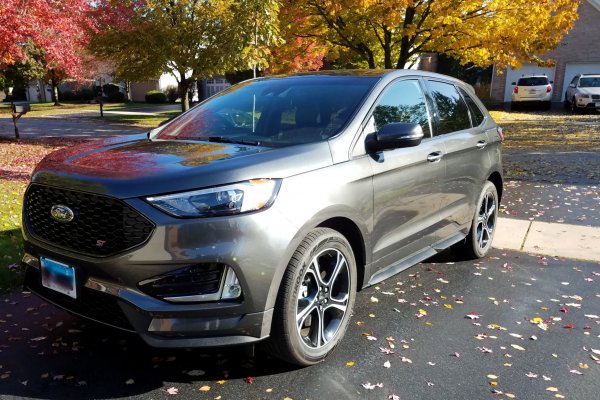-
Posts
95 -
Joined
-
Last visited
-
Days Won
2
Content Type
Profiles
Forums
Gallery
Everything posted by Jombi
-
Thanks! That’s exactly the type of info I’m looking for to fill the gaps in my knowledge.
-
This is just sort of a stream of consciousness essay on my understanding of FWD vs. 4WD vs. AWD. As Dennis Miller used to say, it's just my opinion--I could be wrong! With that said I welcome any and all corrections and clarifications. I seem see a lot of questions and confusion online about the differences between 4WD and AWD, and most of the answers online are vague and sometimes not really accurate. Many of you know all of this already so I'm putting it here for those who don't or may still have questions. I’ve dug fairly deep into this subject and tried to distill what I’ve learned from both reading up on the subject and various you-tube videos on the subject. I highly recommend anything from this site--Engineering Explained https://www.youtube.com/user/EngineeringExplained , they have a great wealth of info and that guy has a very good way of explaining very technical concepts in a way that non tech-nerds can understand. Even still it’s hard to completely nail down the actual real-world mechanics of it all, but here’s my go at it. Again I welcome any corrections, elaborations, etc. I'm not an engineer, just an enthusiast, so my knowledge on the subject is largely informal. Starting from the old days when most cars were 2WD, rear drive: In America the typical cars from the 60s and 70s were mostly open-rear-diff 2WD, so only when on dry pavement did you have 50% torque split of actual useful energy between left and right rear tire, and fortunately this is most of the time so you get equal wear on the components of each side (bearings, gears, and tires wear differently between being dragged and being under torque). However, if you tried to pull up your driveway and the left rear tire was on a patch of ice but the right was on dry pavement--the left rear got 100% of the engine’s torque--which, while scientifically may be "some torque" because it's moving the driveline components and physically turning the tire--but for the context of this discussion, it’s getting zero torque because we're not going anywhere. So the concept of an open differential providing equal torque still stands here--the right rear is providing zero torque as well. Technically, if the driveline resistance to the spinning tire were large enough, then the right wheel might provide some usable torque and therefore motion (more on this later as that's where ABS/Traction Control come in), but the reality is that you were stuck, period, and had to resort to any number of tricks we had back then to get moving. Around that same time, in the early 70's when I was a teen, the only real high-traction option was true 4WD or (4x4). As a 16 year-old, I drove a tow truck/snowplow for a gas station. This tow-truck was a true 4WD--this meant it had a limited slip differential in the rear and a solid-locking differential in the front. These were connected by a transfer case (not a center-differential). Most of these trucks then, as now, were rear-dominant, meaning that in "normal" driving mode the transfer case was in 2WD driving only the rear driveshaft. So in normal mode, even if one rear was in the ice, the centrifugal force of the spinning tire would lock up a clutch in the LSD and the other tire would provide roughly equal torque. Some “4x4” trucks did not have an LSD in the rear (or it wore out over time) so were technically 3x4. However, even with the weight of a tow-hook in the back, this isn't enough to push a big pile of snow, especially when one is sitting in that deep snow to begin with. The front diff on these 4x4s had an open differential with hard-locking capability in the hubs. So to get into true 4x4 mode, step one was to stop the truck, shift the transfer-case to 4wd (4-Lo for snow plowing, 4-Hi for general off-road or heavy snow/mud driving). Step two I'd get out of the truck--usually while still on dry pavement so I stay dry, but where my entry to the snow was a straight line (this is very important because once the hubs are locked, making a turn on dry pavement will bind the tires and/or diff gears when locked)--and I'd twist the hub locker to lock the left and right hubs on the front wheels. The solid locking hubs are much better than an LSD--no waiting for spin to "activate" the other tire--the axle was, for all intents and purposes, a solid shaft from left to right . So in this situation, we have essentially direct-from-the-engine torque at all 4 wheels--no ifs, ands, or buts--the torque is there even if a tire is aloft. With the weight of the plow and engine up front, and the tow-hook in back, there was so much weight/friction at all 4 tires that I was never getting stuck. Once finished "plowing" or, because I was a fun-loving teen at the time "just plain having fun on company time" with the boss’s tow-truck in the nearby woods or a snow or mud covered field, I'd pull out onto the dry-pavement area, get out, unlock the hubs, and shift the transfer case back to 2wd and head back to the station. As an aside, in the snow when you're plowing (and really in almost any snow situation unless the snow is much deeper than your cars ground-clearance) the goal is to get the tires dug down to the pavement, and this particular truck had tall thin snow tires—perfect for that purpose. I’d see other 4x4s with “mudders”—big wide tires—that could get stuck in snow even in full 4x4 mode because they were basically skiing or floating on top of the snow. However, If that heavy tow truck and thin tires were in very wet mud then it has no pavement to dig down to and risks digging itself till it’s frame is settled on the mud and getting stuck, so there is a good case for mudder tires. At one point in the mud I almost needed to get out and wrap the tow-hook around a tree to get me out, but some gentle rocking got me free. FWD—a little better but not the complete solution. In the mid/late 70s, Front-wheel drive came on the market. This was mostly in economy cars made to combat the ongoing gas-crisis. Cars such as the Dodge Omni were typical—these gave a noticeable advantage in traction due to the simple fact that instead of the driving wheels being under the (normally empty) rear trunk of the car, they were under the engine up front, which helped a great deal. ABS/Traction Control were still well over a decade away, but taking advantage of physics this way was a no-brainer and a welcome advance. It also introduced us to understeer and torque-steer, and sadly--unless you had a center lever parking brake in your FWD car--it took away the great fun found in RWD oversteer in big empty parking lots after a fresh snow! Gradually FWD made its way into mainstream sedans and the of course mini-vans, which were coming just over the Omni…er…Horizon (probably only those who remember those Dodge/Plymouth FWD cars models will get that arcane reference!). Fast forward to the days of AWD. AS FWD proved an incremental advantage, more was needed to really overcome the traction issues faced by those driving in snow, ice,and even rain, so in came AWD. The simplest and most generic implementations of AWD at first consisted of three open diffs--front, center, and rear. (this discussion excludes a small variety of makes, like Jeeps, Subarus, Audis, BMW X-drive and a few others that have nearly always had some sort of transfer-case or locking/LSD center differential.) Most of these initial AWD implementations were in SUV's that started life as FWD SUVs. So for the majority of AWD SUVs, the dominant axle is the front, which has shorter and beefier axles, and the AWD option threw in an open center diff with a little prop shaft to the back to turn a couple of pencil-thin rear axles to assist if you hit ice or snow. It’s important to note that most of these front-dominant AWD vehicles even today will only do a max 50/50 split front/rear, because the thinner, longer axles/half-shafts in the rear simply couldn’t handle 100% of the torque if it needed to move close to 100% of the vehicle’s maximum load. They will do their job admirably by helping in snow, even hard-pull 1/4 mile launches on dry pavement, and to help cornering, etc---but in the case of the typical grocery-getter AWD SUV, the rear driveline just isn’t beefy enough to tow a huge boat uphill all by itself--and the carmakers wouldn’t (shouldn't) allow that 0/100 torque split to happen if it didn’t beef up the components. As an example, in my Edge, the front axles are relatively short, thick and stubby with the fat part of the shaft about 1 ¾” diameter while the most tapered part of the shaft has a diameter of 1 3/16”. The narrow part of the shaft is only a couple of inches in length at each end not counting the splines. Contrast that to the rear half-shafts, which are only 7/8” diameter end-to-end, and around two feet long. So if you were stuck crawling up a rocky hill in your AWD SUV with all the 2-plus tons on the back wheels and all the torque is also happened to be at the rear diff—you risk twisting and snapping an axle. If you were able to turn around and go up the rocky hill in reverse using the front dominant axle (thicker shafts), you could make it without damage. But AWD SUVs were never made for rock crawling, so hopefully nobody puts themselves in that situation with a "typical" AWD vehicle. Anyway, from a traction standpoint, AWD at first blush might be seen as a potentially worse situation than a 2wd vehicle. Because now--while you've got the "opportunity" to have four total chances at traction (remembering the concept of the open-differential)--it seems instead that we really just gave ourselves more chances to have a tire happen to be on a patch of ice. Now it's only *one* of four wheels that will really get the torque if you’re in an icy patch--and it'll be the one with the least traction. Fortunately, this is where traction-control comes in. It’s basically implemented the same as it had been implemented in the FWD sedans and SUVs, but now just includes all 4 wheels in the logic. The Trac systems use ABS to clamp the spinning tire, and continues to do so on other tires as they spin until it "finds" the one with the most traction; they also typically throttle-down the engine. So in reality, AWD does in fact provide the advantage of having one tire out of four getting good traction instead of two tires of four--but as anyone who's driven them knows, this comes at the price of a very slow start-off from stop when you’re in snow. With Trac’s throttle-down and the clamping/unclamping different wheels dozens if not hundreds of times per second, you’re just kind of easing your way forward slowly. You do get going but it is nowhere near what a true 4x4 can do. I’d also guess that a 2WD with a Torsen (say, a Mustang GT with a few bags of sand in the trunk) might even do better than an AWD with all open diffs because it will have a positive torque split at two wheels instead of one. Put snow tires on that Mustang against summer tires on the AWD SUV and the Mustang with the Torsen (and don’t forget the bags of sand in the trunk!) has a very clear advantage. In the snow, true snow-tires with 2WD vs. summer tires and AWD is a no brainer—I’ll take the snow tires over virtual slicks any on any vehicle regardless of powertrain. And not just because of the launch traction--you still need to corner and you still need to stop. Waaaay too many people think AWD helps them stop better and corner better in the snow--I've seen too many rear-enders and AWD newbies in the ditch to know that's still the case and there should be a warning on that with a new AWD vehicle--especially with the cheap "good-enough-to-drive-off-the-lot" tires that some of these cars come stock with. So the next iterations of AWD started introducing some sort of LSD for the center-diff, whether it be a viscous clutch, a dry clutch, electronically locking mechanical drum or brake, a Torsen, or some other way of guaranteeing that some torque will go to both front and rear regardless of the traction situation back there. So now instead of 1-of-4 chances at traction, with a locking center diff you have 2 positive chances at traction now--and that is a huge step forward, literally and figuratively. For example I have an AWD Tucson which has an electronically locking center diff, and the difference that center locker makes in snow is very significant and noticeable. The Tucson’s AWD on its own without engaging the center lock was a big leap in snow traction over my old Sonata FWD sedan--but when I hit that locker button that’s a whole different feeling--it’s a real game changer in the snow and even rain. That is until I hit 18 mph when the safety system unlocks it because too many people would leave that locked and end up on dry pavement, making a turn, and tearing up the tires and possibly gears. It’s important to note that the reason for the clunking on dry pavement when the center-diff is locked is not due to the left vs. right tire speed rpm difference in a turn, but instead due to the front vs. rear propshaft rpm difference, because both pairs of outer and inner tires will turn at slightly different speeds—for similar reasons as the left vs. right but it’s a distinction that should be noted. All types of unlocked center diffs compensate for this front/rear rpm difference the same as the front and rear diffs deal with it—the center-diff may have slightly different technology and gear-sets but they accomplish the same goal. Finally... So nowadays most modern AWD SUVs have some sort of LSD in the center to ensure positive propshaft torque to the rear without having to rely on Trac to fake it. However, many still have open diffs in the front and rear and use Trac to simulate an LSD both front and rear, which, while not optimal, is still something. Notable exceptions to this as mentioned at the top would be Jeeps, Subarus, G-wagons, and Land Rovers—most of those come standard with some form of a transfer case and/or locking or LSD for the center-diff. Often they have the option for LSD both front and rear, as well. So for example, a Jeep with a transfer case will always have an advantage over a typical AWD SUV even if it has open front and rear diffs. Not only can they put positive torque on more wheels, the drivelines are also made so both front and rear can carry the entire load if called upon to do so. The minor disadvantage of course is that you still only want to fully lock the front/rear axles when you’re in slushy situations, and unlock it when dry. There are a lot of ways they accomplish this—many are electronic and very convenient. It’s been many, many years since I’ve seen anyone step out of their truck to lock the front hubs! So that's my story and I'm sticking to it but like I said--I could be wrong and welcome corrections and elaborations because I've seen so much confusion over this issue and I'd like to do what I can to clear it up for everyone--including me.
-
" 4th is considered an overdrive gear" Yes this is a bizarre statement coming from a dealer who should know. It may be an "extra" gear (compared to the previous 6-speed) but overdrive is only 7 & 8 in the 8F57; OD is by definition a ratio of less than 1.0: 1.
-
I have not been able to get the time or a safe place to carefully monitor what happens in D mode with 2,3 & 4 shifts. But I've had the TSB applied and I know there is still some strange stuff going on. In paddle-shift/D mode, it almost seems like the display shows 3, then I hear no change, but then it shows 4. In S mode, because it doesn't auto-upshift, it will go into each gear but it really flares when going from 3 to 4. There is definitely some global problem with 3 & 4, perhaps they're just too close and maybe the ECU will only use them both properly when under heavy tow-load or something, otherwise it seems to want to skip but doesn't do it elegantly. I'll see if I can get a chance to really dig into this--I need to be in a safe place because I can only use my ears to tell the gear it's actually in when in D mode. The main TSB issue I had aside from the 3 & 4 was the clunk when going into reverse from park, and that has not happened at all since the fix. The TSB though specifically calls out a flare on the 4-5 shift, and I never had any issue with the 4-5 shift--it was always the skipping of the 3 or 4 (I never could really tell which) that I had issue with.
-
Possbiley for towing heavy stuff around town one might want to have 2nd and 3rd that close...I think most of us are in drag-race mindset so that's why it seems unneeded. It would be nice if Forscan or the tuners (Livernois, etc) could just eliminate a gear via software.
-
I didn’t know the Passport was that quick, but just looked it up and they’re rated at 5.8 to 60, .1 better than the ST. I’m running the 91 octane Livernois tune and my dragy consistently shows ~5.2 0-60, but due to turbo lag, he’d have me off the line but I’d catch him at about 40 mph which is where I really feel the Gs in the back of my seat. I’ll keep my eyes out for the next one!
-
I would also try as someone else mentioned earlier to contact a Ford corporate regional rep. The dealerships do have different priorities than the corporation; the dealer has made their sale, but the corporate rep will care more about reputation and the social media noise you can make. So it's likely they will at least listen, and when confronted with the obvious truth they should help make this right. I always thought that the dealer loses nothing on warranty work so I'm not sure what their motivation would be to refuse it. Maybe they just make less money on it because they're paid some flat fee through corporate, I don't know how that works. But it just seems odd because it's not coming out of the Dealer's pocket to fix a warranty item, so I don't know why there's pushback, maybe someone else has more insight into this.
-
I believe the Titanium with the 2.0 ecoboost uses the 8F35 tranny and not the 8F57, which is the one with the issues. (I have no idea why that image is in my post, I had it for another post and it inserted itself and I can't remove it).
-
I don't know if it's just that now time has gone by and there might be aftermarket competition (though I couldn't find these at any auto parts store), but I get them for about $6 at my Ford dealer.
-
Those Rover owners probably don't know to turn off Trac! I dispatched an X5 40i (the 3.0 twin turbo 335 hp, not the 465 hp 50i). That model X5 rated at 5.3, but I think that includes the .3 rollout, so probably more like 5.6, and my tune gets consistent 5.2 0-60s on dragy. It is fun besting ~$60K-$70K cars with something MSRP ~$45K (tho I pounded the dealer for weeks and got mine for $35.6K)
-
-
I didn't hear any sound for some reason but it appears that, while it displays 3rd gear, it then displays 4th with no RPM drop indicating that it was probably in 4th to begin with, so it's skipping 3rd. Is that what you're saying? Because I think mine skips 3rd as well, but I haven't looked closely since the TSB.
-
Yes definitely they should let you drive it as much as you like. They let me take it home (this dealer was 20 miles away) to show my wife (a sales tactic--but I used it to my advantage). Meanwhile the dealership I could walk to (and did get the TSB applied at and walked home to wait) did not want to come down the $1.5K more I wanted off their third-time-with-the-manager offer, but the boondocks guy did. At least my service location is close. Anyway, everything I've read says that last set of numbers--which is a date--is the build date. Mine's a 2019 model built 3/7/2019.
-
I don’t know when the latest TSB was actually released, or how quickly they can get those into the factory so the cars come out with it already applied. But either way once the TSB is applied, the issues are gone, but it is still not on par with say, how a Porsche Shifts in the near instant paddle response of many sports cars, but then Ford never really claimed it was. I think it’s probably as good shifting with the TSB applied as most every day SUVs, but because it’s an ST I think we all expect a little better.
-
That isn't how LMS instructed me--they say always revert to stock tune when going to a dealer, because the TSB fixes the stock tune, and will be needed for future dealer visits where the ECU might be looked at, and I re-sent that to LMS who returned re-calibrated tunes based on the new stock tune with the TSB applied. The LMS tune I believe has its own shifting strategy so I never had flare or clunk issues with LMS.
-
Same here, I did tell the service manage I'm feeling the clunk from park to reverse and a flare on the 4-5 shift. They were done in an hour. I didn't drive it long enough to really get a solid feel of the difference, though I noticed it didn't clunk and seemed to shift at the right time and quickly without the flare. I put the LMS tune back after just a couple days because I miss that extra punch.
-
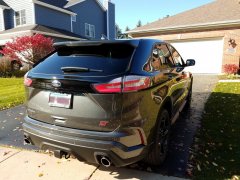
ECU timing product questions.....Livernois vs Race Chip?
Jombi replied to Dieselboy's topic in Accessories & Modifications
I finally got a dragy and was running the mid-level livernois tune (the 91, but using 93 gas). It was a crisp cold night with thick air so I figured it would be a good run. I got 5.18, I'll call it 5.2. I had previously applied the 93 tune, and had been using about a half-can of Torco per tank, which I believe at that ratio will boost to about 94--I may be too nervous about knocking but I really like to know the octane is at least a point ahead of what the tune calls for in case the filling station had a mixup or quality-control issue and the 93 wasn't really 93. Anyway, I didn't have the dragy then and I was on a 500 mile trip (also took extra Torco because 91 is the best some of these out-of-the way places have). But I could feel it is punchier than the 91 in all aspects--especially highway-speed passing! Got in a tight spot on I-80 through Iowa with a parade of cars in the left lane led by a "do gooder" in a a 70mph zone. Finally got my interval on the right side and paddled down to 4 and ROCKETED out and broke free, it felt amazing--sooo much more high-speed pull than stock. And the confident handling and dead-straight tracking of the suspension made 120 feel like 80, and kept my wife from chastising me--that's a plus right there! Once things die down on my other projects I'll put the 93 back in and post dragy results on the 93 tune, this is the 91 with cool thick air. -
Could you share what product you use please? I used to use a spray called LPS on the non-hot bolts & metal, and then permatex high-heat antiseize to coat the exhaust hardware—that saved me a bundle on a cat pipe change once. Without coating the threads, they’d be toast after 3 years. After 5 years I put a socket on these, loosened them without too much sweat and they practically spun off just with my fingers! Easiest exhaust work I’d ever done.
-
The only aesthetically significant mod is the tailpipe tips. Otherwise, the car has the Livernois tune, currently running the 91 version. I also swapped out the weak single horn for the dual horn. The closeup of the lower grill shows how nuts I got with detailing--somehow I don't think that dedication will last. But after 1500 miles those 6-sided diamonds had gook in the edges and I spent way more time than I care to admit cleaning them! All that's there now is the reflection of leaves in my driveway.
-
From the album: Jims 2019 Edge ST
2019 ST with Livernois 91 (mid-level) tune. About 30 deg. air which I'm sure helped. I still don't have a convenient safe place to do a 1/4 so I'm just doing 0-60s. Stock tune was 5.95 0-60. I did brake-hold to about 2500 rpm and let it go. Trac was off, and I heard multiple tires chirp--that probably had to do with the all-seasons I had on--very hard rubber in the cold. (I just put Hankook WinterCept Evo's on yesterday). -

Can Forscan enable showing the active gear?
Jombi replied to Jombi's topic in Accessories & Modifications
I'm getting too old and busy to do much mods--I'd love to open up the intake and exhaust, but for now it's drop-in filter and the Livernois tune. Using Dragy, my stock 0-60 was 5.95. Using the LMS 91 octane tune (with 93 gas) I got a 5.45. I haven't tried the LMS 93 octane tunewith the Dragy yet, but I expect it to be 5.2-ish. --Jim -

Can Forscan enable showing the active gear?
Jombi replied to Jombi's topic in Accessories & Modifications
Dang...I've already got Livernois. Thanks though. --Jim -

Can Forscan enable showing the active gear?
Jombi replied to Jombi's topic in Accessories & Modifications
Ok, found it, looks like not currently possible. Back in the day when 3-speed auto was the norm we always knew what gear we were in...I guess mo’ gears, mo’ problems! -
And I’ll quickly add “when in normal D mode, not Sport or Paddle mode”. I just want to know what gear I’m in, I want to see when it’s skipping a gear, etc, but it seems it only shows the current gear# when you use the paddles. Thanks, Jim
-
Not sure if Ford does this, but some of the upper-end performance carmakers shoe their cars with "lot tires", basically something to last 5-10K miles because at that level most buyers have personal tire preferences, especially if they're doing a lot of track time. It's kind of like buying a printer--those ink cartridges they come with out-of-the-box are 1/4 full and you're buying a new cartridge halfway through your first run of Christmas letters. I checked the tread depth at the lot and the ST's Hankook's had close to 10/32, which is about normal for a new tire. With the average tire burning 1/32 every 6K miles, and 2/32 being the minimum, that's about 48K miles so definitely these are "real" tires and not "drive-off-the-lot" tires.



